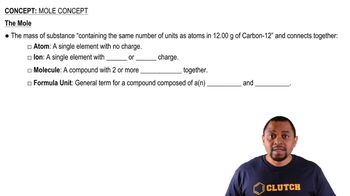Here are the essential concepts you must grasp in order to answer the question correctly.
Molarity
Molarity (M) is a measure of concentration defined as the number of moles of solute per liter of solution. It is expressed in moles per liter (mol/L) and is crucial for calculating the amount of solute in a given volume of solution. Understanding molarity allows one to determine how many moles of a substance are present in a specific volume, which is essential for stoichiometric calculations in chemistry.
Recommended video:
Moles
A mole is a fundamental unit in chemistry that quantifies the amount of substance. One mole contains approximately 6.022 x 10²³ entities, such as atoms or molecules, known as Avogadro's number. Moles provide a bridge between the atomic scale and macroscopic quantities, allowing chemists to relate mass, volume, and concentration in chemical reactions and solutions.
Recommended video:
Volume and Concentration Relationship
The relationship between volume and concentration is critical in determining the amount of solute in a solution. The formula used is: moles of solute = molarity (M) × volume (L). This relationship allows for the calculation of moles when the molarity and volume of a solution are known, facilitating various applications in laboratory settings and chemical reactions.
Recommended video:
Relationship of Volume and Moles Example
 Verified step by step guidance
Verified step by step guidance


